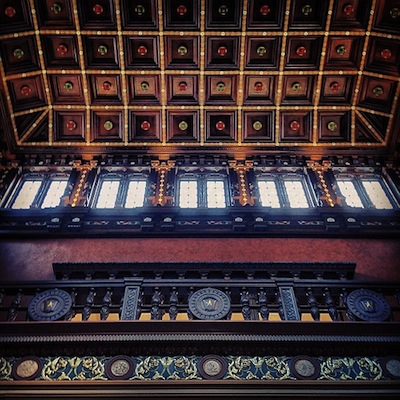
- Westin Hotels in the Galleria Sell for $220M [Prime Property]
- Houston Finally Becoming a ‘Real City’ with Increased Highrise Living [Houstonia Magazine; previously on Swamplot]
- $84M Sugar Land Concert and Theater Venue To Have 6,500 Seats [Houston Chronicle ($)]
- Pesca, Alberto Alfonzo’s Second Restaurant in River Oaks Shopping Center, Closes [Culturemap]
- Austin Hipster Nightclub Barbarella Moves Into Midtown in Former Status Lounge [Rant & Rave]
- Galveston Yacht Basin Ready To Open [Galveston County Daily News ($)]
- Voodoo Queen Now Open in the East End [Eater Houston; previously on Swamplot]
- Plans for Ellington Airport Spaceport To Be Unveiled Today [CBS Houston]
- US-59 from I-10 to 288 Among Most Congested Freeways in Texas, Finds State Report [Houston Chronicle ($)]
- Texas Historical Landmark Smartphone App Worth the Four Bucks [Hair Balls]
Photo of the interior of Houston Public Library’s Julia Ideson building: Molly Block via Swamplot Flickr Pool





I love this:
“Many Houston-area freeways have limited space and widening them or adding elevated lanes is cost-prohibitive.”
This is total BS. The downtown logjams suffer from inadequate imagination and misdirected priorities. how is it that we’re spending billions of $’s on tollways in areas with no traffic issues when we have 4 out of the top 10 most congested highways in Texas?
The imagination portion is what’s really maddening. How can the public gauge true costs when TXDot doesn’t even look at adding tunnels or some sort of public private partnership. A 10 billion dollar I 45 tunnel project can be a lot more palatable when you consider that TXDot can sell the downtown right of way to developers. Depressing a freeway like 59 from the spur to 288 then CAPPING it creates valuable land that could be sold and built upon. Not to mention that the 45/59/288 section is not at a lane capacity and the retaining walls could be re-engineered to add even MORE lanes.
There is less $ to go around TXDot. We get it. So quit spending $ on suburban tollways to fatten the wallets of master planned community developers and start addressing real congestion problems.
what hacks me off is that they are spending money to replace the access road along 59 and it isnt even in bad shape!! How about paving Richmond or Westheimer inside the loop?? wtf? the 59,288, downtown spur mess was rebuilt 15 years ago and 0 lanes added, a huge Houston folly.
Overall, building additional lane miles does little if anything to solve congestion. How big a pain it is to drive a given stretch of road at a given time is something with which most commuters are very familiar, and that goes into their calculations of whether it’s worth it to take that route at that time. There are alternatives – different routings, different times, different transportation methods, etc.
I’ve mentioned this before, but the Embarcadero Freeway in San Francisco is a case in point. People loathed it for being this elevated double decker wall between the Financial District and the Bay, but the will to actually do away with it didn’t come to fruition until it was heavily damaged during the Loma Prieta quake, and people realized that traffic was actually moving BETTER without it – it was being diffused across the street grid rather than being funneled into a choke point.
Unfortunately, the Galleria area is pretty much stuck with its gridlock, in large part because when it was built they actually removed some streets in order to have a bunch of disconnected suburban type campus developments. Trying to replace or build that infrastructure now is prohibitive; and as hostile to walking as that area is I’m going to be interested in seeing how the BRT will actually fare.
@DNAguy: part of the issue is that the tollroads are coming out of a separate pot of money than the money used to build/widen existing freeways in the central part of the city. The HCTRA does not used tax dollars, but monies raised through bonds backed by future tolls.
That said, there is a lack of imagination and money here for transit solutions as the urban core grows more dense and we add population at a rapid clip.
@DNAguy: Google “big dig”.
My understanding is that the 59 widening (access roads) has to do with that segment meeting the federal standards it needs to be designated as a part of I-69. Still a terrible waste of money though.
@OldSchool: I’ve lived in Boston. Yeah, the construction & going over budget sucked (not to mention the leaking tunnels), but I don’t think anyone misses the ugly Central Artery. The city is better because of the Big Dig.
@ Old School
“…the Big Dig, was a megaproject in Boston that rerouted the Central Artery (Interstate 93), the chief highway through the heart of the city, into a 3.5-mile (5.6-km) tunnel. The project also included the construction of the Ted Williams Tunnel (extending Interstate 90 to Logan International Airport), the Leonard P. Zakim Bunker Hill Memorial Bridge over the Charles River, and the Rose Kennedy Greenway in the space vacated by the previous I-93 elevated roadway”
Replacing the Pierce elevated with tunnels and capping a 59 isn’t close to the same magnitude of complexity.
I thought the 59 service road work was due to the Upper Kirby TIRZ being flush with money and desire to say they have replaced all roads and driven everyone crazy in the process.
The 59 frontage road reconstruction is $18,116,888.08 of TxDOT funds. Upper Kirby is assisting with coordination.